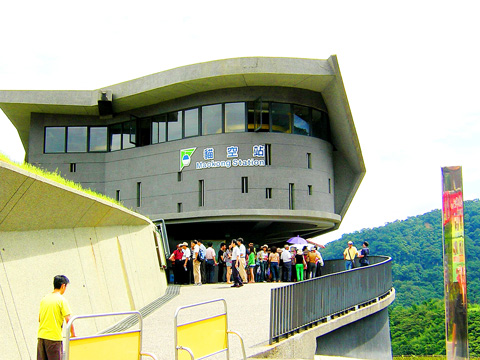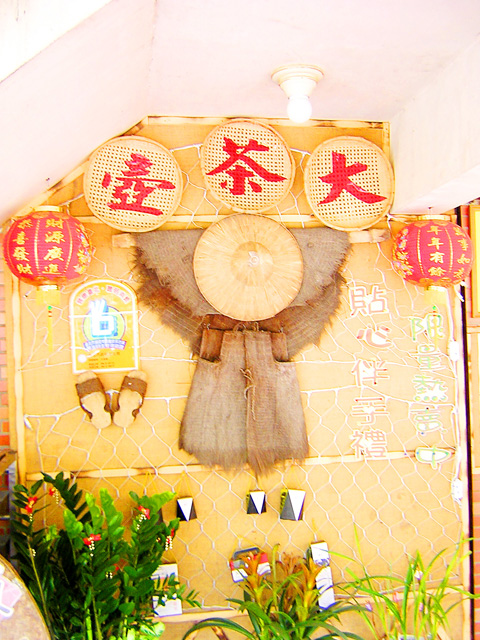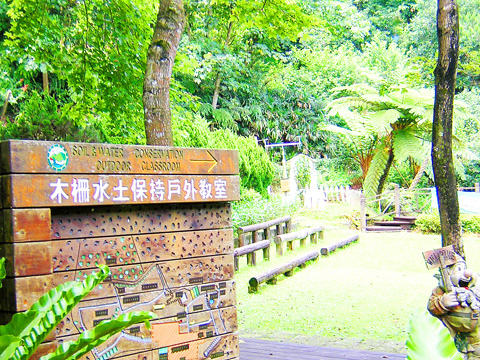
PHOTO: MAC WILLIAM BISHOP
Even on a rainy weekday, dozens of people queue in front of the Maokong Gondola (貓空纜車) before it opens at 9am, waiting to be carried from the bleakness of daily life into a haven of green hills and breezy teahouses.
Since it first opened on July 4, 2007, the Maokong Gondola has carved out a niche as one of Taipei’s “must-see” attractions.
Maokong (literally “no cat” in Mandarin), in the foothills of Taipei City’s Wenshan District, is said to derive its name from a Hoklo homophone that refers to the rugged, craggy topography of the hills, which resemble cat footprints.

PHOTO: MAC WILLIAM BISHOP
The area is known for its tea plantations and accompanying teahouses, and has long been a popular getaway for local residents. However, the treacherous approach — narrow and winding beyond the norm for mountain roads in Taiwan — was a hindrance to exploitation of Maokong’s tourism potential.
For this reason, Taipei City Government began construction of the gondola system in partnership with the French firm POMA in 2005.
Despite some initial misgivings about its reliability and the usual complaints and opposition that accompany such large-scale infrastructure projects, the Maokong Gondola has been a success in terms of popularity and its impact on local businesses.

PHOTO: MAC WILLIAM BISHOP
It’s no surprise, either. With stunning views of Taipei framed by verdant hills, Maokong offers a blend of natural and man-made diversions that few areas so easily accessible from Taipei City have to offer.
Part of the draw is the area’s rich history as one of the centers of Taiwan’s tea industry.
TEA IS KING
Maokong is surrounded by tea plantations and filled with teahouses.
The main reason local tourists are flocking to Maokong is to indulge in Chinese “tea culture” at its finest.
As you exit the terminal Maokong Station, one of the first things you will see is a veritable wall of signs indicating different places to visit in the area. The bulk of the signs are for teahouses.
You will also find a number of billboards posted around Maokong showing three walking tours — red, blue and yellow — which are a combination of streets and footpaths with teahouses, shops and other attractions liberally dispersed along the route.
The best teahouses in Maokong will give you a combination of good food, great tea and relaxing views with a nice breeze and clean environment. Given that there are more than 40 teahouses in Maokong, the location and the quality can vary widely.
As you look for a teahouse that suits you, you will have time to enjoy the views of Wenshan District’s tea plantations. Wenshan is renowned for two types of oolong tea: tieguanyin (鐵觀音) and baozhong (包種) teas.
Tieguanyin (Iron Goddess of Mercy) and baozhong are examples of oolong tea, although baozhong is often described as one of the lightest of the types and very nearly a green tea.
As with most famous types of tea in Chinese culture, there are several myths and historical stories attached to these brands, some more picturesque than others.
Nowadays, the finer examples of these two types of tea can sell for upwards of US$500 per kilogram — more per gram than some types of illicit narcotics.
This, of course, points to one of the driving forces behind Maokong and its tourism — an effort to protect the economic interests of an agricultural sector.
As with farmers throughout the country, Taiwan’s tea growers are concerned about increased competition after Taiwan’s accession to the WTO in 2002, as well as a general downturn in Taiwan’s tea industry.
So if drinking tea is (ahem) your cup of tea, Maokong will be heaven.
For some insights into the technical side of the tea industry, you may want to check out the Taipei Promotion Center for Tie Kuanyin and Pachung Tea (台北市鐵觀音包種茶研發推廣中心), just down the road from Maokong Station. The center has a tearoom, agricultural demonstrations, as well as displays of equipment from the tea-growing industry and various teas and tea-drinking accoutrements.
WALKING AROUND
Steeping yourself in tea culture need not be the only reason to go to Maokong. Just unwinding and enjoying the views while riding the Maokong Gondola is itself a welcome diversion from city life.
There are several public hiking trails in the area, some of which are better maintained than others. Innumerable dirt trails wander between and through tea plantations, but as most of these are on private land, your presence may not be appreciated.
Forests of camphor trees, perfuming the land with a pleasant scent, surround the plantations. You will also commonly encounter Taiwan acacia, Chinese hackberry and king’s fig.
Meanwhile, as you ascend into Maokong in your gondola car, listen for the distinctive cries of the colorfully plumed black-browed barbet.
Crested serpent eagles are also frequently heard. They can be commonly seen floating on the thermals rising between the hills, keeping a watch for unwary lizards or basking snakes.
As you glide above them, the sounds of the city begin to fade and you start to relax — assuming your companions in the gondola car are not screaming and sighing as though they are on a roller-coaster ride. Even if they are, you’ll probably forgive them.
It is easy to be charitable while floating above Maokong’s hills.
If you go
Getting there:
From Taipei Main Station, take the MRT Bannan Line to Zhongxiao Fuxing station, and transfer to the Muzha Line. Take the Muzha Line south to its terminus, Taipei City Zoo station. Depart from exit No. 2. The Maokong Gondola’s Taipei Zoo Station is a five-minute walk away.
Several buses will take you near Taipei Zoo Station, including No. 236, No. 237, No. 282, No. 294, No. 295 and No. 611; Brown No. 3, Brown No. 6, Brown No. 11 and Brown No. 15; Small No. 12 (小12號); and Green No. 1.
Ample parking is available near the Maokong Gondola’s Taipei Zoo Station.
Maokong Gondola:
You can use a Taipei City EasyCard to pay for the ride, or purchase tickets at the station. A single, one-way fare from Taipei Zoo Station (動物園站) to the terminal Maokong Station (貓空站) is NT$50.
The one-way journey from the bottom to the top (just over 4km) takes around 20 minutes, although expect to wait in line for 20 to 30 minutes both ascending and descending at most times. Waits may be considerably longer — an hour or more — on holidays and weekends.
Hours of operation:
Monday: Closed
Tuesdays through Fridays: 9am to 10pm (last ascent is at 9:30pm)
Weekends and holidays: 8:30am to 10pm (last ascent is at 9:30pm)
Teahouses:
There are dozens of teahouses in Maokong, so your best bet is to wander into a place that looks pleasant. Teahouses typically offer a variety of snacks and standard dishes representative of Chinese cooking in Taiwan. The big draw is the tea: most will have a selection of green and oolong teas, varying in price from NT$120 to NT$380 for a standard tea service. Fine teas become progressively more expensive in accordance with their rarity.
Here are two locations near Maokong Station with good selections of tea and excellent views:
Big Teapot Tea Emporium (大茶壺茶棧)
37, Ln 38, Zhinan Road Sec 3, Wenshan Dist, Taipei City
(台北市文山區指南路三段38巷37號之1)
Telephone: (02) 2939-5057
Hours: 11am to 6pm or later (depending on amount of custom)
Mountain Water Inn (文山客)
10, Lane 40, Zhinan Road Sec 3, Wenshan Dist, Taipei City
(台北市文山區指南路三段40巷10號)
Telephone: (02) 2234-1239 or (02) 8661-9421
On the Net: www.ample.com.tw
Hours: Open 24 hours a day
Other food and refreshment:
The gondola stations have a variety of concessionaires offering the standard snacks and refreshments one will find anywhere in Taiwan, from milk tea and fruit juice to lunch boxes and sandwiches.
There are also numerous street stalls immediately outside of Maokong Station, offering a slightly wider variety of typical Taiwanese street food.

Taiwan doesn’t have a lot of railways, but its network has plenty of history. The government-owned entity that last year became the Taiwan Railway Corp (TRC) has been operating trains since 1891. During the 1895-1945 period of Japanese rule, the colonial government made huge investments in rail infrastructure. The northern port city of Keelung was connected to Kaohsiung in the south. New lines appeared in Pingtung, Yilan and the Hualien-Taitung region. Railway enthusiasts exploring Taiwan will find plenty to amuse themselves. Taipei will soon gain its second rail-themed museum. Elsewhere there’s a number of endearing branch lines and rolling-stock collections, some

Could Taiwan’s democracy be at risk? There is a lot of apocalyptic commentary right now suggesting that this is the case, but it is always a conspiracy by the other guys — our side is firmly on the side of protecting democracy and always has been, unlike them! The situation is nowhere near that bleak — yet. The concern is that the power struggle between the opposition Chinese Nationalist Party (KMT) and their now effectively pan-blue allies the Taiwan People’s Party (TPP) and the ruling Democratic Progressive Party (DPP) intensifies to the point where democratic functions start to break down. Both

The Democratic Progressive Party (DPP), Chinese Nationalist Party (KMT), and the country’s other political groups dare not offend religious groups, says Chen Lih-ming (陳立民), founder of the Taiwan Anti-Religion Alliance (台灣反宗教者聯盟). “It’s the same in other democracies, of course, but because political struggles in Taiwan are extraordinarily fierce, you’ll see candidates visiting several temples each day ahead of elections. That adds impetus to religion here,” says the retired college lecturer. In Japan’s most recent election, the Liberal Democratic Party lost many votes because of its ties to the Unification Church (“the Moonies”). Chen contrasts the progress made by anti-religion movements in

This was not supposed to be an election year. The local media is billing it as the “2025 great recall era” (2025大罷免時代) or the “2025 great recall wave” (2025大罷免潮), with many now just shortening it to “great recall.” As of this writing the number of campaigns that have submitted the requisite one percent of eligible voters signatures in legislative districts is 51 — 35 targeting Chinese Nationalist Party (KMT) caucus lawmakers and 16 targeting Democratic Progressive Party (DPP) lawmakers. The pan-green side has more as they started earlier. Many recall campaigns are billing themselves as “Winter Bluebirds” after the “Bluebird Action”